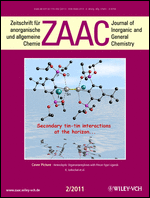|
|
|
|
Journal
Publications |
|
Phosphorus NMR and Ab Initio Modelling of P-N Bond Rotamers of a
Sterically Crowded Chiral β-P4S3 Diamide
Bruce W. Tattershall,
Julian G. Knight and Mark J. Andrews, Z. Anorg. Allg. Chem.,
2007,
633, 1442. |
|
Abstract:
Reaction of bicyclic β-P4S3I2
with enantiomerically pure (R)-Hpthiq
(1-phenyl-1,2,3,4-tetrahydroisoquinoline) and Et3N gave a
solution of a single diastereomer of the unusually stable diamide β-P4S3(pthiq)2,
accounting for 83 % of the phosphorus content. Despite the steric bulk
of the substituents, each amide group of this could adopt either of two
rotameric positions about their P-N bonds, so that, at 183 K, 31P
NMR multiplets for four rotamers could be observed and the spectra of
three of them analysed fully. The large 2J(P-P-P) coupling became
greater (253, 292, 304 Hz) with decreasing abundance of the individual
rotamers. The rotamers were modelled at the ab initio RHF/3-21G* level,
and relative NMR chemical shifts predicted by the GIAO method using a
locally dense basis set, allowing the observed spectra to be assigned to
structures. Calculations at the same level for the model compound α-P4S3(pthiq)Cl
confirmed the assignments of low-temperature rotamers of α-P4S3(pthiq)I
reported previously. Changes in observed P-P coupling constants and
31P chemical shifts, on rotating a pthiq substituent, could then
be compared between β-P4S3(pthiq)2 and
α-P4S3(pthiq)I, confirming both sets of
assignments. The most abundant rotamer of β-P4S3(pthiq)2
was not the one with the least sterically crowded sides of both
pthiq substituents pointing towards the P4S3 cage,
because of interaction between the two substituents. Only by using a DFT
method could relative abundances of rotamers of β-P4S3(pthiq)2
be predicted to be in the observed order. Use of racemic Hpthiq gave
also the two diastereomers of β-P4S3(pthiq)2
with Cs symmetry, for which the room temperature 31P{1H} NMR
spectra were analysed fully.
|
| |
|
|
|



